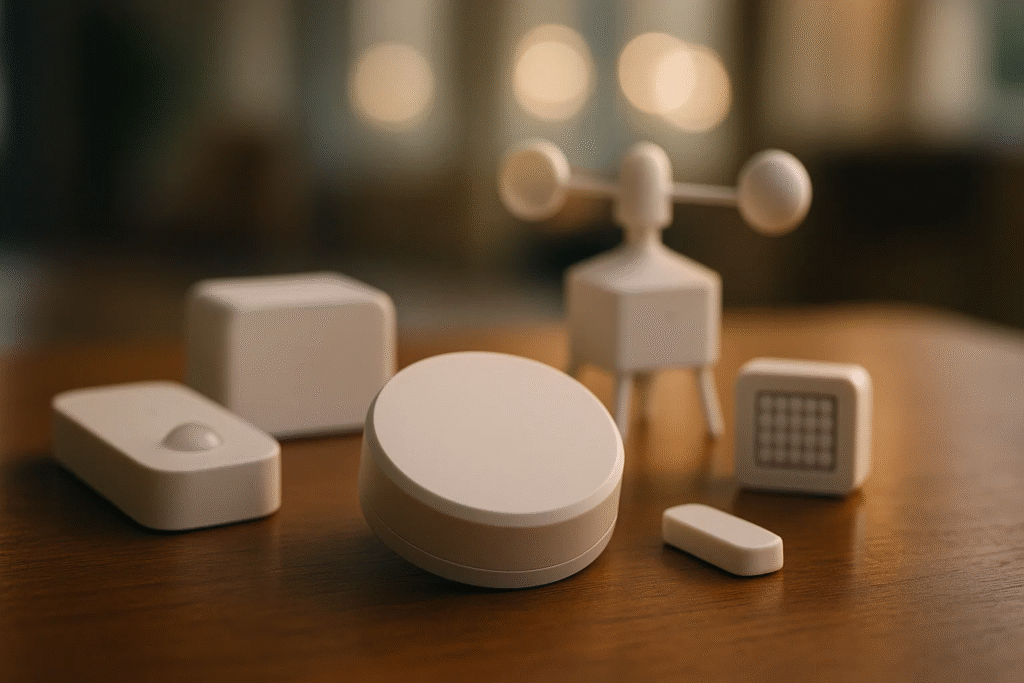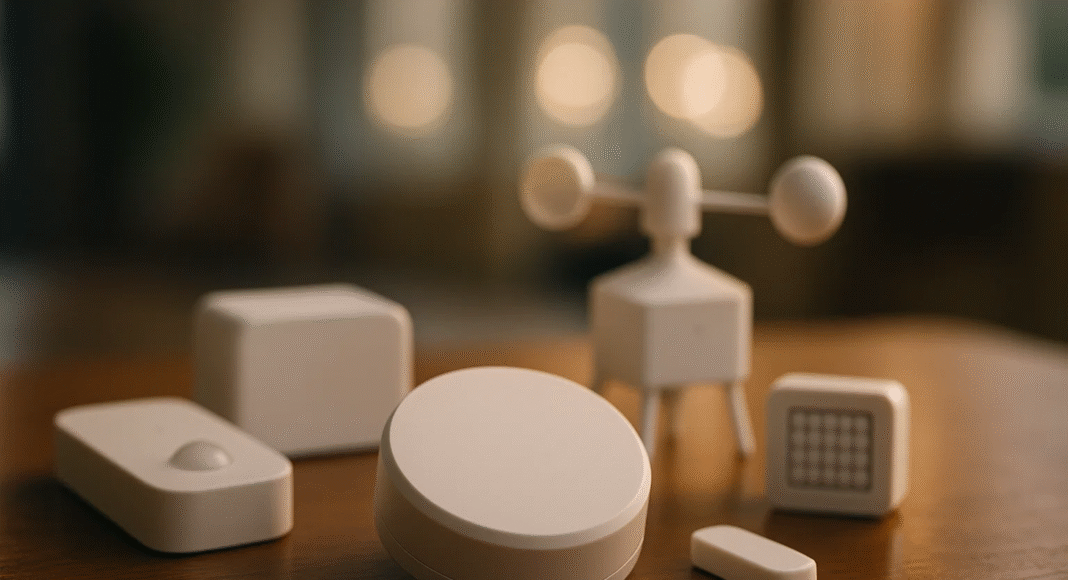Key Takeaways
- IoT sensors collect real-time data from physical environments to enable automation, monitoring, and smarter decision-making.
- Various types of sensors, including temperature, motion, and pressure, serve specialized roles across industries.
- Understanding how IoT sensors work helps businesses unlock efficiency, reduce costs, and drive digital transformation.
The rapid advancement of technology has ushered in a new era where connectivity extends far beyond computers and smartphones, penetrating the physical world through the Internet of Things (IoT). At the heart of this transformative ecosystem lie IoT sensors—sophisticated devices that enable the collection, transmission, and analysis of data from the environment, machines, and even human bodies. Understanding what IoT sensors are and how they function is fundamental to appreciating the profound impact they have on modern industries, smart homes, healthcare, agriculture, and urban development.

IoT sensors serve as the critical interface between the physical world and the digital realm. Unlike traditional sensors that often operate in isolation, IoT sensors are designed to be networked, allowing real-time data exchange over the internet or other wireless communication protocols. This interconnectedness enables automated systems to monitor conditions, make intelligent decisions, and trigger appropriate actions without human intervention, driving efficiency, productivity, and innovation on an unprecedented scale.
In this comprehensive exploration, we will delve deep into the nature of IoT sensors, examining their core functionalities, types, and the technologies that power them. We will uncover the intricate processes by which these sensors detect physical phenomena such as temperature, motion, light, and chemical composition, converting these inputs into actionable digital data. Furthermore, we will analyze the essential role of connectivity technologies—including Wi-Fi, Bluetooth, Zigbee, and emerging networks like NB-IoT—that facilitate seamless communication between sensors, gateways, and cloud platforms.
The applications of IoT sensors are as diverse as they are transformative. From enabling smart homes that optimize energy use and enhance security to revolutionizing healthcare through remote patient monitoring, these sensors are integral to creating smarter, more responsive environments. Industrial sectors leverage IoT sensors for predictive maintenance and operational efficiency, while smart cities depend on them to manage traffic flows, monitor pollution, and maintain infrastructure effectively. As we navigate through the various use cases, it becomes evident that IoT sensors are not just devices but pivotal enablers of the intelligent systems shaping our future.
Despite their widespread adoption, IoT sensors come with challenges that must be addressed to unlock their full potential. Issues such as data security, privacy concerns, power management, and network reliability are critical factors that influence sensor performance and user trust. Additionally, ensuring data accuracy and integrating new sensor technologies with existing infrastructure require ongoing innovation and strategic planning.
Looking ahead, the future of IoT sensors promises exciting developments. Advances in miniaturization, energy harvesting, and artificial intelligence integration are set to enhance sensor capabilities, making them more autonomous, efficient, and intelligent. These trends will further accelerate the proliferation of IoT solutions across industries, paving the way for smarter ecosystems and more informed decision-making.
By the end of this detailed guide, readers will gain a thorough understanding of what IoT sensors are, how they operate, and why they are indispensable components of the IoT landscape. Whether you are a technology enthusiast, a business leader, or simply curious about the devices shaping our connected world, this blog will provide valuable insights into the fundamental building blocks of the Internet of Things.
Before we venture further into this article, we would like to share who we are and what we do.
About 9cv9
9cv9 is a business tech startup based in Singapore and Asia, with a strong presence all over the world.
With over nine years of startup and business experience, and being highly involved in connecting with thousands of companies and startups, the 9cv9 team has listed some important learning points in this overview of What are IoT Sensors & How Do They Work.
If your company needs recruitment and headhunting services to hire top-quality employees, you can use 9cv9 headhunting and recruitment services to hire top talents and candidates. Find out more here, or send over an email to [email protected].
Or just post 1 free job posting here at 9cv9 Hiring Portal in under 10 minutes.
What are IoT Sensors & How Do They Work
- What Are IoT Sensors?
- Types of IoT Sensors
- How Do IoT Sensors Work?
- Applications of IoT Sensors
- Benefits of IoT Sensors
- Challenges and Considerations in Using IoT Sensors
- Future Trends in IoT Sensor Technology
1. What Are IoT Sensors?
Understanding IoT sensors begins with grasping their fundamental role in the Internet of Things ecosystem. IoT sensors act as the primary data collectors, capturing physical or environmental information and converting it into digital signals that can be processed and analyzed. These sensors are embedded in various devices and systems to enable smart functionality and automation.
Definition and Core Concept
- IoT Sensors Explained:
- Devices designed to detect and measure physical quantities such as temperature, motion, light, pressure, or chemical composition.
- Convert these physical inputs into electrical signals that can be digitized and transmitted over networks.
- Integral components of IoT devices, enabling real-time monitoring and control.
- Difference Between Traditional Sensors and IoT Sensors:
- Traditional sensors typically operate standalone and require manual data retrieval.
- IoT sensors are networked, allowing continuous data transmission to centralized systems or cloud platforms.
- Enhanced with connectivity modules (Wi-Fi, Bluetooth, Zigbee, etc.) to enable seamless integration with IoT infrastructures.
- Often optimized for low power consumption and miniaturization to suit various applications.
Key Characteristics of IoT Sensors
- Connectivity:
- Ability to communicate wirelessly with other devices or IoT gateways.
- Common protocols include Wi-Fi, Bluetooth Low Energy (BLE), Zigbee, LoRaWAN, and NB-IoT.
- Low Power Consumption:
- Designed to operate efficiently for extended periods on batteries or energy harvesting methods.
- Critical for sensors deployed in remote or inaccessible locations.
- Miniaturization:
- Compact size enables embedding in wearable devices, smart home appliances, industrial equipment, and more.
- Real-Time Data Collection:
- Provide continuous or periodic data streams for immediate processing.
- Facilitate proactive decision-making and automation.
Examples of IoT Sensors in Use
| Sensor Type | Application Example | Description |
|---|---|---|
| Temperature Sensor | Smart Thermostats (e.g., Nest) | Measures ambient temperature to control HVAC systems for energy efficiency. |
| Motion Sensor | Security Systems | Detects movement to trigger alarms or activate lighting in smart homes. |
| Humidity Sensor | Agriculture | Monitors soil moisture to optimize irrigation schedules and improve crop yield. |
| Light Sensor | Smart Lighting | Adjusts indoor lighting based on natural light availability for energy savings. |
| Gas Sensor | Industrial Safety | Detects hazardous gas leaks in manufacturing plants to prevent accidents. |
| Accelerometer | Wearable Fitness Trackers | Measures user activity, motion, and orientation for health monitoring. |
Detailed Subtypes of IoT Sensors
- Environmental Sensors:
- Monitor parameters like temperature, humidity, air quality, and atmospheric pressure.
- Example: Air quality sensors in smart cities track pollution levels to issue health advisories.
- Motion and Position Sensors:
- Include accelerometers, gyroscopes, and proximity sensors.
- Used in automotive systems for stability control and in smartphones for screen orientation.
- Optical Sensors:
- Detect light intensity, color, or images.
- Commonly found in smart lighting systems and security cameras.
- Chemical Sensors:
- Identify the presence and concentration of gases or chemicals.
- Applied in environmental monitoring and healthcare diagnostics.
- Biometric Sensors:
- Measure physiological signals such as heart rate, glucose levels, or oxygen saturation.
- Crucial in wearable health devices and remote patient monitoring.
Table: Comparison of Common IoT Sensor Types
| Sensor Category | Measurement Parameter | Typical Use Case | Advantages | Limitations |
|---|---|---|---|---|
| Temperature | Ambient or object temperature | Smart thermostats, HVAC | Accurate, low power | Sensitive to rapid fluctuations |
| Motion | Movement, acceleration | Security, fitness tracking | Real-time detection | Can be affected by environmental noise |
| Humidity | Moisture levels in air/soil | Agriculture, weather stations | Critical for environmental control | Calibration needed over time |
| Light | Light intensity, color | Smart lighting, displays | Enhances energy efficiency | Limited functionality in darkness |
| Gas | Concentration of gases | Industrial safety, pollution monitoring | Prevents hazards | Requires frequent calibration |
| Biometric | Vital signs | Healthcare wearables | Enables health monitoring | Privacy and data security concerns |
Importance of IoT Sensors in the IoT Ecosystem
- Serve as the foundation for data-driven decisions by capturing accurate and timely information.
- Enable automation by triggering actions based on sensor readings (e.g., adjusting lighting, activating alarms).
- Facilitate remote monitoring and control, reducing the need for physical presence.
- Provide scalable solutions adaptable across multiple industries, from smart homes to industrial automation.
- Act as enablers for advanced technologies such as AI and machine learning by feeding critical data inputs.
In summary, IoT sensors are the fundamental building blocks of the Internet of Things. Their ability to detect physical phenomena and seamlessly transmit data enables a wide array of smart applications that improve efficiency, safety, and convenience across diverse sectors. As IoT technology continues to evolve, sensors will become even more sophisticated, smaller, and power-efficient, expanding their impact and transforming how we interact with the world.
2. Types of IoT Sensors
IoT sensors come in a diverse range of types, each designed to measure specific physical or environmental phenomena. The wide variety of sensors enables IoT systems to monitor everything from environmental conditions to human health, supporting numerous applications across industries. Understanding the different types of IoT sensors and their unique functionalities is crucial for selecting the right sensor for a given IoT solution.
Environmental Sensors
- Purpose:
- Measure parameters related to the natural environment such as temperature, humidity, air quality, and atmospheric pressure.
- Common Types:
- Temperature Sensors: Detect ambient or object temperatures.
- Example: Smart thermostats like Nest use temperature sensors to maintain home comfort and optimize energy use.
- Humidity Sensors: Measure moisture content in the air or soil.
- Example: Agriculture IoT devices use soil moisture sensors to automate irrigation and improve crop yields.
- Air Quality Sensors: Detect pollutants such as CO2, particulate matter (PM2.5), and volatile organic compounds (VOCs).
- Example: Smart city systems use air quality sensors to monitor pollution and alert residents during poor air conditions.
- Pressure Sensors: Monitor atmospheric or fluid pressure.
- Example: Weather stations and industrial processes rely on pressure sensors for accurate data.
- Temperature Sensors: Detect ambient or object temperatures.
Motion and Position Sensors
- Purpose:
- Detect movement, orientation, and positioning of objects or persons.
- Common Types:
- Accelerometers: Measure acceleration forces in multiple directions.
- Example: Wearable fitness trackers use accelerometers to count steps and track physical activity.
- Gyroscopes: Measure angular velocity or rotation.
- Example: Smartphones use gyroscopes for screen orientation and gaming controls.
- Proximity Sensors: Detect the presence or absence of objects nearby without physical contact.
- Example: Smart lighting systems activate when a person enters a room using proximity sensors.
- Magnetometers: Measure magnetic fields to determine direction (compass functionality).
- Example: Used in navigation devices and smartphones to provide accurate directional information.
- Accelerometers: Measure acceleration forces in multiple directions.
Optical Sensors
- Purpose:
- Detect light intensity, color, or images.
- Common Types:
- Light Sensors: Measure ambient light levels.
- Example: Smartphones adjust screen brightness automatically using light sensors.
- Infrared (IR) Sensors: Detect IR radiation, often used for motion detection or remote controls.
- Example: Security systems use IR sensors for night vision and motion-triggered alarms.
- Image Sensors: Capture visual data for cameras and vision systems.
- Example: Used in surveillance cameras and autonomous vehicles for object recognition.
- Light Sensors: Measure ambient light levels.
Chemical Sensors
- Purpose:
- Detect and measure chemical compositions or gas concentrations.
- Common Types:
- Gas Sensors: Detect gases such as methane, carbon monoxide, oxygen, and toxic gases.
- Example: Industrial safety systems use gas sensors to detect leaks and prevent accidents.
- pH Sensors: Measure acidity or alkalinity in liquids.
- Example: Water quality monitoring in agriculture and environmental studies.
- Biosensors: Detect biological elements or chemicals.
- Example: Glucose sensors in medical devices monitor blood sugar levels for diabetes management.
- Gas Sensors: Detect gases such as methane, carbon monoxide, oxygen, and toxic gases.
Biometric Sensors
- Purpose:
- Measure physiological data related to human health.
- Common Types:
- Heart Rate Sensors: Monitor pulse and heart rate variability.
- Example: Fitness wearables like Fitbit and Apple Watch track heart health during exercise.
- Oxygen Saturation Sensors (SpO2): Measure oxygen levels in the blood.
- Example: Used in healthcare for monitoring patients with respiratory conditions.
- Electrocardiogram (ECG) Sensors: Record electrical activity of the heart.
- Example: Advanced health monitoring devices enable early detection of heart abnormalities.
- Heart Rate Sensors: Monitor pulse and heart rate variability.
Acoustic Sensors
- Purpose:
- Detect sound waves and vibrations.
- Common Types:
- Microphones: Capture audio signals for communication or monitoring.
- Example: Voice assistants like Amazon Alexa rely on microphones to interpret voice commands.
- Ultrasonic Sensors: Measure distance or detect objects using high-frequency sound waves.
- Example: Automotive parking sensors use ultrasonic technology to assist drivers.
- Microphones: Capture audio signals for communication or monitoring.
Table: Summary of IoT Sensor Types, Applications, and Key Benefits
| Sensor Type | Measurement Parameter | Typical Applications | Key Benefits |
|---|---|---|---|
| Environmental Sensors | Temperature, humidity, air quality | Smart homes, agriculture, weather monitoring | Real-time environmental data; energy savings |
| Motion Sensors | Movement, acceleration | Security, fitness, automotive | Enhanced safety; activity tracking |
| Optical Sensors | Light intensity, images | Smartphones, security, autonomous vehicles | Improved automation and visual monitoring |
| Chemical Sensors | Gas concentration, pH | Industrial safety, water quality | Hazard detection; environmental protection |
| Biometric Sensors | Heart rate, oxygen levels | Healthcare, wearables | Health monitoring and diagnostics |
| Acoustic Sensors | Sound waves, vibrations | Voice assistants, automotive | Improved user interaction and safety |
Visual Chart: Distribution of IoT Sensor Usage Across Industries
| Industry | % Use of Environmental Sensors | % Use of Motion Sensors | % Use of Biometric Sensors | % Use of Chemical Sensors |
|---|---|---|---|---|
| Smart Homes | 35% | 25% | 10% | 5% |
| Healthcare | 10% | 15% | 50% | 10% |
| Agriculture | 40% | 10% | 5% | 20% |
| Industrial IoT | 25% | 30% | 5% | 25% |
| Smart Cities | 30% | 20% | 5% | 15% |
Summary
- IoT sensors encompass a broad spectrum of device types, each specialized to monitor specific environmental, physiological, or physical parameters.
- Selecting the appropriate sensor type is essential for meeting the unique requirements of each IoT application.
- The integration of multiple sensor types within an IoT system often provides a comprehensive understanding of complex environments or processes.
- Continuous advancements in sensor technology are expanding the possibilities for more precise, efficient, and cost-effective IoT solutions.
3. How Do IoT Sensors Work?
IoT sensors are critical components of the Internet of Things ecosystem, enabling smart devices to collect, process, and transmit data from the physical world to digital platforms. Understanding how these sensors function provides insights into their role in automation, real-time monitoring, and data-driven decision-making.
Basic Working Principle of IoT Sensors
- Sensing Physical Phenomena:
- IoT sensors detect specific physical, chemical, or biological phenomena such as temperature, motion, light, humidity, or gas concentration.
- They rely on transduction mechanisms to convert these phenomena into measurable electrical signals.
- Signal Conversion:
- The detected physical input is converted into an analog electrical signal.
- Sensors use various transducers depending on the type of measurement, e.g., thermocouples for temperature, piezoelectric elements for vibration.
- Signal Conditioning:
- Raw analog signals are often weak or noisy and require amplification, filtering, or modulation.
- Signal conditioning circuits prepare the sensor output for accurate digital conversion.
- Analog-to-Digital Conversion (ADC):
- Most IoT sensors include an ADC module or interface with an external ADC to convert the analog signals into digital data.
- Digital signals are easier to process, store, and transmit over networks.
Data Transmission in IoT Sensor Systems
- Connectivity and Communication Protocols:
- After conversion, digital data is transmitted to IoT gateways, cloud platforms, or edge devices for processing.
- Common wireless protocols include Wi-Fi, Bluetooth Low Energy (BLE), Zigbee, LoRaWAN, and cellular (NB-IoT, LTE-M).
- The choice of protocol depends on factors like range, data rate, power consumption, and network topology.
- Example:
- A smart thermostat’s temperature sensor measures room temperature and transmits the data wirelessly to a home automation hub using Wi-Fi, enabling remote temperature control.
Processing and Interpretation of Sensor Data
- Edge Computing:
- Some IoT sensors or devices perform initial data processing at the edge, near the data source, to reduce latency and bandwidth usage.
- Example: An industrial vibration sensor detects anomalies locally and triggers immediate alerts without sending all raw data to the cloud.
- Cloud Computing:
- Sensor data is often sent to cloud platforms where it is aggregated, analyzed, and visualized.
- Advanced analytics, machine learning, and AI algorithms extract meaningful insights from sensor data.
Power Supply and Management
- Power Sources:
- IoT sensors are powered by batteries, wired electricity, or energy harvesting techniques (solar, vibration, thermal).
- Battery life is critical for sensors deployed in remote or hard-to-reach locations.
- Power Optimization:
- Sensors utilize low-power modes, duty cycling, and energy-efficient communication protocols to extend operational lifetime.
- Example: Environmental sensors in remote forests use solar power combined with low-power LoRaWAN communication to function for years without maintenance.
Step-by-Step Example: How a Temperature Sensor in a Smart Home Works
- Detection:
- The temperature sensor’s thermistor detects ambient temperature changes by altering its electrical resistance.
- Signal Conversion:
- The resistance change is converted into an analog voltage signal proportional to temperature.
- Signal Conditioning:
- The analog signal is amplified and filtered to remove noise.
- Digital Conversion:
- An onboard ADC converts the analog voltage into digital data representing temperature in degrees Celsius or Fahrenheit.
- Transmission:
- The digital temperature data is sent via Wi-Fi to the smart home hub.
- Processing:
- The hub processes the data and adjusts the HVAC system accordingly or sends notifications to the homeowner’s smartphone.
Table: Key Components and Their Functions in IoT Sensor Operation
| Component | Function | Example Device/Technology |
|---|---|---|
| Sensor Element | Detects physical/chemical stimuli | Thermistor (temperature), MEMS accelerometer (motion) |
| Signal Conditioner | Amplifies and filters raw sensor signals | Operational amplifiers, filters |
| ADC (Analog-to-Digital Converter) | Converts analog signals to digital format | ADC chips integrated in microcontrollers |
| Microcontroller Unit (MCU) | Processes sensor data and manages communication | Arduino, ESP32 |
| Communication Module | Transmits data wirelessly or via wired protocols | Wi-Fi, BLE, Zigbee, LoRaWAN |
| Power Supply | Provides energy to sensor and components | Batteries, solar cells |
Challenges in IoT Sensor Operation
- Accuracy and Calibration:
- Sensors may drift or degrade over time; periodic calibration is necessary to maintain accuracy.
- Example: Gas sensors require frequent calibration to ensure precise pollutant detection.
- Data Security and Privacy:
- Secure transmission protocols and data encryption are essential to protect sensitive sensor data.
- Interference and Noise:
- Environmental factors can introduce noise, affecting signal quality and reliability.
- Proper shielding and filtering techniques are applied to minimize interference.
Visual Chart: IoT Sensor Data Flow
Physical Phenomenon → Sensor Element → Signal Conditioning → ADC → Microcontroller Processing → Wireless Transmission → Cloud Platform → Data Analytics & Visualization
In conclusion, IoT sensors operate through a series of steps involving detection, signal conversion, data processing, and wireless transmission. Their seamless integration into connected systems enables real-time monitoring and automation across diverse applications such as smart homes, industrial automation, healthcare, and environmental monitoring. Advances in sensor technology, connectivity protocols, and power management continue to enhance their performance and expand their use cases.
4. Applications of IoT Sensors
IoT sensors serve as the foundational technology powering numerous smart applications across a wide range of industries. Their ability to collect and transmit real-time data transforms traditional processes, improves efficiency, enhances safety, and drives innovation. This section explores the diverse applications of IoT sensors, providing concrete examples and insights into their impact.
Smart Homes and Buildings
- Energy Management:
- IoT sensors monitor electricity, gas, and water usage in real time to optimize consumption.
- Example: Smart meters combined with occupancy sensors adjust heating, ventilation, and air conditioning (HVAC) based on room usage.
- Benefits: Reduced utility bills and lower carbon footprint.
- Security and Surveillance:
- Motion sensors, door/window sensors, and cameras enable real-time intrusion detection.
- Example: Smart security systems like Ring or Nest use sensors to detect unusual activity and alert homeowners.
- Comfort and Convenience:
- Environmental sensors (temperature, humidity, light) automatically adjust lighting and climate control systems.
- Example: Philips Hue lighting adjusts brightness and color temperature based on ambient light detected by sensors.
Industrial IoT (IIoT)
- Predictive Maintenance:
- Vibration, temperature, and pressure sensors monitor machinery health to predict failures before they occur.
- Example: Siemens uses vibration sensors on turbines to detect imbalances early and schedule maintenance proactively.
- Impact: Reduces downtime and maintenance costs.
- Process Optimization:
- Sensors track production line parameters such as speed, temperature, and material flow to optimize efficiency.
- Example: General Electric employs sensors in factories to fine-tune manufacturing processes and improve yield.
- Worker Safety:
- Wearable sensors monitor environmental conditions (gas leaks, temperature extremes) and worker biometrics.
- Example: Honeywell’s connected safety solutions alert workers and managers of hazardous conditions in real time.
Healthcare and Medical Applications
- Remote Patient Monitoring:
- IoT sensors track vital signs such as heart rate, blood pressure, oxygen levels, and glucose levels.
- Example: Devices like Fitbit and continuous glucose monitors (CGMs) provide real-time data to patients and healthcare providers.
- Asset Tracking:
- Sensors monitor medical equipment location and condition within hospitals.
- Example: RFID tags track wheelchairs, defibrillators, and IV pumps to reduce equipment loss.
- Smart Implants and Prosthetics:
- Embedded sensors provide feedback on implant status and patient activity.
- Example: Smart pacemakers monitor heart rhythms and adjust stimulation accordingly.
Agriculture and Environmental Monitoring
- Precision Agriculture:
- Soil moisture, temperature, and nutrient sensors optimize irrigation and fertilization schedules.
- Example: John Deere integrates IoT sensors in tractors and fields to improve crop yields and reduce resource waste.
- Livestock Monitoring:
- Wearable sensors track animal health, activity, and location.
- Example: Cowlar’s smart collars monitor dairy cows for early detection of illness or heat cycles.
- Environmental Protection:
- Sensors detect pollution levels, weather changes, and natural disasters.
- Example: Air quality sensors monitor urban pollution, helping authorities respond to hazardous conditions.
Transportation and Logistics
- Fleet Management:
- GPS, temperature, and motion sensors track vehicle location, cargo conditions, and driver behavior.
- Example: UPS uses IoT sensors to optimize delivery routes and monitor refrigerated goods.
- Smart Traffic Systems:
- Road sensors detect traffic volume and congestion, enabling dynamic traffic light control.
- Example: Smart cities like Barcelona utilize traffic sensors to improve traffic flow and reduce emissions.
- Asset Tracking:
- IoT sensors enable real-time tracking of shipments and containers.
- Example: Maersk uses IoT-enabled containers to monitor environmental conditions and improve supply chain visibility.
Table: Summary of IoT Sensor Applications Across Industries
| Industry | Key Applications | Typical Sensors Used | Benefits |
|---|---|---|---|
| Smart Homes | Energy management, security | Motion, temperature, humidity, light sensors | Energy savings, enhanced safety |
| Industrial IoT | Predictive maintenance, safety | Vibration, temperature, pressure sensors | Reduced downtime, worker safety |
| Healthcare | Remote monitoring, asset tracking | Heart rate, glucose, RFID sensors | Improved patient care, asset control |
| Agriculture | Precision farming, livestock | Soil moisture, temperature, GPS sensors | Increased yields, resource efficiency |
| Transportation | Fleet management, traffic control | GPS, temperature, motion sensors | Optimized logistics, reduced congestion |
Future Trends in IoT Sensor Applications
- Integration with AI and Machine Learning:
- IoT sensor data is increasingly processed with AI for predictive analytics and autonomous decision-making.
- Example: AI-powered irrigation systems adjust watering schedules based on sensor data and weather forecasts.
- Expansion in Smart Cities:
- Sensors monitor infrastructure health, waste management, and public safety.
- Example: Smart lighting systems dim or brighten based on pedestrian movement detected by sensors.
- Enhanced Environmental Monitoring:
- Networks of sensors track climate change indicators and support disaster management efforts.
Visual Chart: IoT Sensor Data Usage by Industry
Industry | Data Usage Intensity
------------------|----------------------
Smart Homes | High
Industrial IoT | Very High
Healthcare | High
Agriculture | Medium
Transportation | High
In summary, IoT sensors are transforming virtually every industry by enabling smarter operations, improved safety, and data-driven insights. From smart homes to agriculture, healthcare, and transportation, the applications of IoT sensors continue to expand, driving innovation and efficiency in the digital age.
5. Benefits of IoT Sensors
IoT sensors serve as the backbone of the Internet of Things ecosystem, offering a multitude of advantages that drive innovation and efficiency across various industries. These benefits span operational improvements, cost reductions, enhanced safety, and better decision-making capabilities. This section explores the diverse benefits of IoT sensors in detail, supported by examples and data.
Operational Efficiency and Automation
- Real-Time Data Collection:
- IoT sensors provide continuous monitoring and instant data feedback from physical environments.
- Example: Manufacturing plants use temperature and vibration sensors to monitor machinery, enabling timely maintenance and preventing unplanned downtime.
- Automation of Processes:
- Sensor data triggers automatic adjustments in systems without human intervention.
- Example: Smart irrigation systems use soil moisture sensors to automatically control watering schedules, reducing water waste.
- Reduced Human Error:
- Automated sensor-driven systems minimize manual data collection and operational mistakes.
- Example: Automated inventory tracking via RFID sensors reduces errors in stock management in warehouses.
Cost Savings and Resource Optimization
- Energy Efficiency:
- IoT sensors optimize energy consumption by providing precise control over heating, lighting, and equipment operation.
- Example: Smart buildings equipped with occupancy sensors switch off lights and HVAC systems when rooms are empty, significantly reducing energy costs.
- Predictive Maintenance:
- Sensors detect early signs of equipment failure, allowing repairs before costly breakdowns occur.
- Example: Airlines use vibration and temperature sensors in engines to schedule predictive maintenance, reducing downtime and maintenance expenses.
- Optimized Resource Use:
- Agriculture benefits from sensor-based monitoring of soil and weather to optimize water, fertilizer, and pesticide application.
- Example: Precision farming techniques use IoT sensors to increase crop yields while minimizing resource waste.
Enhanced Safety and Security
- Hazard Detection:
- IoT sensors monitor environmental hazards such as gas leaks, fire, or structural weaknesses.
- Example: Gas leak sensors in chemical plants detect dangerous concentrations early, triggering alarms and automatic shutoff systems.
- Workforce Safety:
- Wearable sensors monitor workers’ health metrics and environmental conditions in real time.
- Example: Construction workers wear IoT-enabled helmets that detect impacts or hazardous gas exposure, improving emergency response.
- Physical Security:
- Motion, proximity, and biometric sensors enhance access control and intrusion detection.
- Example: Smart locks and security cameras use sensor data to grant or restrict access and alert owners of unauthorized entry.
Improved Decision-Making and Insights
- Data-Driven Analytics:
- The vast amount of sensor data enables advanced analytics and machine learning models to identify patterns and trends.
- Example: Retail stores analyze foot traffic and customer behavior data collected via sensors to optimize store layouts and marketing strategies.
- Remote Monitoring and Control:
- IoT sensors enable monitoring of assets and environments remotely, facilitating timely interventions.
- Example: Healthcare providers remotely monitor patients’ vital signs through wearable sensors, allowing proactive care.
- Scalability and Flexibility:
- Sensor networks can be scaled easily to cover larger areas or new applications without significant infrastructure changes.
- Example: Smart city projects progressively expand sensor deployment for traffic, air quality, and public safety monitoring.
Table: Summary of IoT Sensor Benefits with Industry Examples
| Benefit | Description | Industry Example |
|---|---|---|
| Operational Efficiency | Real-time monitoring and process automation | Manufacturing: Predictive maintenance |
| Cost Savings | Energy optimization and resource management | Smart Buildings: Automated lighting control |
| Enhanced Safety | Hazard detection and worker protection | Oil & Gas: Gas leak sensors |
| Improved Decision-Making | Analytics and remote monitoring | Healthcare: Remote patient monitoring |
| Scalability | Easy expansion and integration | Smart Cities: Traffic and pollution sensors |
Environmental and Sustainability Benefits
- Reduced Carbon Footprint:
- IoT sensors help minimize energy waste and optimize resource use, contributing to lower greenhouse gas emissions.
- Example: Smart grids use sensors to balance energy loads and integrate renewable sources efficiently.
- Waste Reduction:
- Sensors enable precision in agriculture and manufacturing, reducing excess use of water, chemicals, and raw materials.
- Example: Water quality sensors in irrigation reduce runoff and soil contamination.
Visual Chart: Impact of IoT Sensors on Business KPIs
| KPI | Improvement Percentage (Typical Range) |
|---|---|
| Operational Efficiency | 20% – 40% |
| Maintenance Costs | 15% – 30% |
| Energy Consumption | 10% – 35% |
| Safety Incidents | 25% – 50% |
| Decision-making Speed | 30% – 60% |
Challenges and Considerations to Maximize Benefits
- Data Security:
- Protecting sensor data from breaches is essential to maintain trust and comply with regulations.
- Example: Encryption and secure protocols ensure data integrity in healthcare sensor networks.
- Interoperability:
- Compatibility between sensors and IoT platforms is critical for seamless integration.
- Example: Standardized communication protocols like MQTT and CoAP facilitate interoperability.
- Sensor Calibration and Maintenance:
- Regular calibration ensures sensor accuracy and reliability over time.
- Example: Environmental sensors in pollution monitoring require frequent calibration to maintain data quality.
In summary, IoT sensors offer a broad spectrum of benefits that empower industries to improve efficiency, reduce costs, enhance safety, and make smarter decisions. Their ability to provide real-time, accurate data drives the ongoing digital transformation across sectors such as manufacturing, healthcare, agriculture, smart cities, and beyond.
6. Challenges and Considerations in Using IoT Sensors
While IoT sensors offer transformative benefits across industries, deploying and managing these technologies is not without challenges. Addressing these obstacles is critical to ensuring the reliability, security, and overall effectiveness of IoT sensor networks. This section delves into the key challenges and considerations organizations must evaluate when implementing IoT sensors.
Data Security and Privacy Concerns
- Vulnerability to Cyberattacks:
- IoT sensors often operate in distributed environments with limited security controls, making them targets for hacking.
- Example: In 2016, the Mirai botnet exploited unsecured IoT devices, including sensors, causing massive internet outages.
- Data Privacy Issues:
- Sensors frequently collect sensitive personal or operational data, raising concerns over unauthorized access or misuse.
- Example: Healthcare sensors monitoring patient vitals must comply with HIPAA regulations to protect patient privacy.
- Encryption and Authentication:
- Ensuring data transmitted by sensors is encrypted and access-controlled reduces risk.
- Consideration: Implementing end-to-end encryption and multi-factor authentication protocols is essential.
Interoperability and Standardization
- Diverse Sensor Types and Protocols:
- IoT ecosystems comprise numerous sensor brands and communication protocols, complicating integration.
- Example: Some sensors use Zigbee, others use LoRaWAN or MQTT, requiring middleware or gateways to communicate effectively.
- Lack of Universal Standards:
- The absence of widely accepted IoT standards results in fragmented systems and vendor lock-in.
- Consideration: Adopting sensors compliant with open standards improves scalability and flexibility.
- Data Format Incompatibility:
- Different sensors output data in various formats, requiring normalization before analytics.
- Solution: Use IoT platforms capable of ingesting and standardizing heterogeneous data streams.
Power Management and Battery Life
- Limited Energy Sources:
- Many IoT sensors operate in remote or hard-to-reach locations with limited access to power.
- Example: Environmental sensors in forests or agricultural fields rely on battery or solar power.
- Battery Drain and Sensor Lifespan:
- Frequent data transmission and sensing activities deplete batteries quickly, impacting operational continuity.
- Consideration: Deploy low-power communication protocols (e.g., NB-IoT, Bluetooth Low Energy) and energy harvesting techniques.
- Maintenance Costs:
- Regular battery replacement or sensor servicing increases operational expenses.
- Example: In large sensor networks, maintenance logistics can become complex and costly.
Data Management and Scalability
- Volume of Sensor Data:
- IoT sensors generate vast amounts of data, requiring robust storage, processing, and bandwidth.
- Consideration: Implement scalable cloud storage and edge computing solutions to handle big data efficiently.
- Real-Time Processing Needs:
- Some applications demand near-instantaneous data analysis and response, challenging traditional architectures.
- Example: Autonomous vehicles require real-time sensor data processing to make immediate decisions.
- Data Quality and Accuracy:
- Sensor faults, calibration drift, and environmental interference can degrade data quality.
- Solution: Establish regular calibration schedules and deploy data validation algorithms.
Environmental and Physical Challenges
- Harsh Operating Conditions:
- Sensors deployed outdoors or in industrial settings face temperature extremes, moisture, dust, and vibrations.
- Example: Oil rig sensors must withstand corrosive environments and intense weather.
- Physical Damage and Tampering:
- Sensors can be accidentally damaged or intentionally tampered with, risking data loss or security breaches.
- Consideration: Use ruggedized sensor housings and tamper-evident designs.
- Placement and Coverage Issues:
- Improper sensor placement can lead to blind spots or inaccurate readings.
- Example: In smart agriculture, soil sensors must be carefully distributed to capture representative data.
Cost and ROI Considerations
- Initial Deployment Costs:
- Purchasing, installing, and integrating sensors can require significant upfront investment.
- Consideration: Perform cost-benefit analyses and pilot projects before full-scale deployment.
- Ongoing Operational Expenses:
- Maintenance, data management, and security expenses add to total cost of ownership (TCO).
- Example: Sensor networks in large smart cities require dedicated teams for upkeep and troubleshooting.
- Return on Investment (ROI):
- Measuring the tangible benefits derived from sensor data can be complex, especially in early stages.
- Solution: Define clear KPIs and milestones to track performance improvements and savings.
Table: Summary of Challenges and Considerations for IoT Sensors
| Challenge | Description | Mitigation Strategies | Industry Examples |
|---|---|---|---|
| Data Security | Cyberattacks, data breaches | Encryption, authentication, compliance | Healthcare, Smart Cities |
| Interoperability | Diverse protocols and data formats | Use open standards, middleware platforms | Manufacturing, Smart Homes |
| Power Management | Battery life limits, remote power access | Low-power protocols, energy harvesting | Agriculture, Environmental Monitoring |
| Data Management | Large data volumes, real-time processing needs | Cloud computing, edge analytics | Autonomous Vehicles, Retail |
| Environmental Factors | Harsh conditions, physical damage | Rugged hardware, protective casings | Oil & Gas, Industrial IoT |
| Cost & ROI | High upfront and operational costs | Pilot projects, clear KPI definitions | Smart Cities, Manufacturing |
Visual Chart: IoT Sensor Deployment Challenges by Frequency of Occurrence
| Challenge | Frequency (%) Based on Industry Surveys |
|---|---|
| Data Security | 38% |
| Interoperability | 26% |
| Power Constraints | 18% |
| Data Management | 10% |
| Environmental Issues | 8% |
Regulatory and Compliance Considerations
- Compliance with Industry Standards:
- Depending on the application, IoT sensors must meet specific regulatory requirements.
- Example: Medical sensors comply with FDA regulations; industrial sensors may need to meet OSHA or ISO standards.
- Data Governance and Privacy Laws:
- GDPR, CCPA, and other data protection laws impact how sensor data is collected, stored, and shared.
- Consideration: Implement transparent data policies and secure data anonymization techniques.
Summary
Effectively managing the challenges associated with IoT sensors requires a comprehensive approach covering security, interoperability, power, data, environmental conditions, and costs. Addressing these considerations ensures the successful deployment and sustainable operation of IoT sensor networks, unlocking their full potential across various industries.
7. Future Trends in IoT Sensor Technology
The evolution of IoT sensor technology is accelerating rapidly, driven by advancements in materials science, wireless communications, artificial intelligence, and data analytics. Understanding emerging trends is essential for businesses and technologists seeking to leverage the next generation of IoT sensors for enhanced efficiency, accuracy, and innovation. This section explores the key future trends shaping IoT sensor technology.
Advanced Sensor Materials and Miniaturization
- Nanomaterials and Flexible Sensors:
- Utilization of graphene, carbon nanotubes, and other nanomaterials enables ultra-sensitive, flexible, and lightweight sensors.
- Example: Wearable health monitors using flexible sensors can conform to skin, providing continuous biometric data without discomfort.
- Miniaturization for Embedded Applications:
- Continuous reduction in sensor size allows integration into small devices such as smart pills for internal diagnostics or micro-robots.
- Consideration: Smaller sensors reduce power consumption and enable deployment in previously inaccessible locations.
- Self-Healing and Biodegradable Sensors:
- Future sensors may incorporate materials that self-repair or safely degrade, reducing electronic waste and maintenance.
- Example: Biodegradable environmental sensors deployed in forests for temporary monitoring.
Enhanced Connectivity with 5G and Beyond
- Ultra-Low Latency and High Bandwidth:
- 5G networks facilitate real-time data transmission from IoT sensors, supporting applications like autonomous vehicles and industrial automation.
- Example: Smart factories use 5G-enabled sensors to instantly detect and correct production anomalies.
- Massive IoT Device Support:
- 5G’s network slicing and massive machine-type communications (mMTC) allow millions of sensors to connect seamlessly in dense environments.
- Consideration: Enables smart cities to monitor traffic, pollution, and infrastructure simultaneously at scale.
- Edge and Fog Computing Integration:
- Coupling 5G with edge computing pushes data processing closer to the sensor source, reducing latency and bandwidth demands.
- Example: In remote mining operations, edge-enabled sensors analyze data locally, sending only critical alerts over 5G.
Artificial Intelligence and Machine Learning Integration
- Smart Sensor Analytics:
- Embedding AI/ML algorithms within sensors allows on-device data preprocessing, anomaly detection, and predictive maintenance.
- Example: Vibration sensors on manufacturing equipment autonomously detect early signs of mechanical failure.
- Adaptive Sensing:
- Sensors dynamically adjust sensitivity and sampling rates based on environmental context, optimizing energy use and data relevance.
- Consideration: AI-driven adaptive sensing extends battery life and improves accuracy.
- Federated Learning for Privacy:
- Decentralized ML models train across distributed sensors without sharing raw data, enhancing privacy and reducing bandwidth.
- Application: Healthcare IoT sensors collaboratively improve diagnostic models without exposing patient data.
Energy Harvesting and Sustainable Power Solutions
- Ambient Energy Harvesting:
- Sensors increasingly use solar, thermal, vibrational, or radiofrequency energy harvesting to operate indefinitely without batteries.
- Example: Smart agriculture sensors powered by solar cells and soil moisture gradients for continuous field monitoring.
- Wireless Power Transfer:
- Emerging technologies enable remote wireless charging of sensors, eliminating physical maintenance visits.
- Consideration: Critical for sensors in hazardous or inaccessible locations.
- Ultra-Low Power Electronics:
- Advances in semiconductor design reduce power consumption, enabling longer sensor lifespans and smaller form factors.
- Example: Bluetooth Low Energy (BLE) 5.2 sensors optimized for wearable devices.
Advanced Sensor Fusion and Multimodal Sensing
- Integration of Multiple Sensor Types:
- Combining data from different sensor modalities (e.g., temperature, humidity, pressure) improves overall system accuracy and insight.
- Example: Environmental monitoring stations use sensor fusion to accurately assess air quality indices.
- Context-Aware Systems:
- Sensors interpret contextual information to provide actionable insights rather than raw data streams.
- Application: Smart home sensors distinguish between human presence and pets to optimize energy usage.
- Enhanced Precision and Resolution:
- Sensor fusion algorithms refine measurement accuracy beyond individual sensor capabilities.
- Consideration: Critical for applications like precision agriculture and autonomous navigation.
Security Enhancements and Blockchain Integration
- Hardware-Based Security Modules:
- Sensors increasingly incorporate embedded security chips for encryption and tamper detection.
- Example: Industrial sensors with built-in Trusted Platform Modules (TPM) prevent unauthorized access.
- Blockchain for Data Integrity:
- Distributed ledger technologies enable secure, transparent, and tamper-proof recording of sensor data.
- Application: Supply chain sensors use blockchain to verify product origin and condition.
- AI-Powered Threat Detection:
- Sensors integrated with AI monitor for unusual behavior or cyberattacks in real-time, triggering defensive actions.
- Consideration: Essential for critical infrastructure IoT deployments.
Table: Comparison of Current vs. Future IoT Sensor Capabilities
| Feature | Current Sensors | Future Sensors |
|---|---|---|
| Size | Millimeter scale | Micro and nano scale |
| Power Source | Batteries, wired power | Energy harvesting, wireless charging |
| Connectivity | Wi-Fi, Bluetooth, Zigbee | 5G, 6G, advanced LPWAN |
| Data Processing | Cloud-centric | Edge AI-enabled, on-device analytics |
| Security | Basic encryption, password protection | Hardware security modules, blockchain |
| Sensing Modalities | Single or few modalities | Multimodal fusion, adaptive sensing |
| Deployment Environment | Controlled or semi-controlled | Harsh, remote, wearable, implantable |
Emerging Industry Use Cases and Examples
- Smart Cities:
- Future IoT sensors enable comprehensive urban monitoring—traffic flow, pollution, waste management—with real-time AI analytics.
- Example: Barcelona’s smart city initiatives integrate 5G-connected, AI-enhanced sensors for energy-efficient street lighting and air quality monitoring.
- Healthcare and Wearables:
- Advanced biosensors monitor continuous health metrics such as glucose, oxygen levels, and cardiac rhythms with predictive AI insights.
- Example: Implantable sensors communicating through 5G networks for remote patient monitoring.
- Industrial IoT (IIoT):
- Predictive maintenance using AI-powered vibration and thermal sensors reduces downtime and optimizes operations.
- Example: Siemens integrates multimodal sensors with edge AI to monitor gas turbines.
- Agriculture:
- Precision farming employs energy-harvesting soil and climate sensors with adaptive sampling to optimize irrigation and crop yields.
- Example: John Deere’s connected equipment uses sensor fusion to analyze soil conditions in real time.
Visual Chart: Projected Growth Areas in IoT Sensor Technology (2025-2030)
| Sector | CAGR (%) Projected | Key Technological Drivers |
|---|---|---|
| Healthcare | 22% | Wearable biosensors, implantables |
| Smart Cities | 18% | 5G connectivity, AI analytics |
| Industrial IoT | 20% | Predictive maintenance, edge computing |
| Agriculture | 15% | Energy harvesting, sensor fusion |
| Consumer Electronics | 12% | Miniaturization, flexible sensors |
Conclusion
The future of IoT sensor technology is characterized by smarter, smaller, and more energy-efficient devices tightly integrated with next-generation networks and AI capabilities. These advancements will unlock unprecedented possibilities across sectors, enabling more responsive, secure, and sustainable IoT ecosystems. Staying ahead of these trends will be critical for organizations aiming to leverage IoT sensors for competitive advantage in the coming decade.
Conclusion
IoT sensors are no longer emerging technologies—they are now essential enablers of intelligent automation, real-time data analysis, and digital transformation across nearly every sector. From consumer electronics and healthcare devices to industrial machines and urban infrastructure, these sensors serve as the fundamental building blocks of the Internet of Things (IoT), acting as gateways between the physical world and digital systems.
The comprehensive exploration of what IoT sensors are, the types available, how they operate, and where they are applied reveals not only their current utility but also their enormous potential to revolutionize how individuals, businesses, and governments interact with the world around them. Each sensor type—be it temperature, pressure, motion, gas, proximity, or biometric—fulfills a distinct function, contributing to an interconnected ecosystem that thrives on precision, efficiency, and automation.
Reinforcing the Role of IoT Sensors in Modern Technology
- Data is the new currency, and sensors are the collectors:
IoT sensors gather highly granular data, enabling advanced analytics, decision-making, and automation at an unprecedented scale. Whether monitoring energy consumption in smart homes or tracking humidity levels in agricultural fields, they drive digital insight and operational intelligence. - Cross-industry applications demonstrate versatility:
The deployment of IoT sensors across industries—from healthcare and manufacturing to transportation and environmental monitoring—underscores their flexibility and critical importance in building smarter systems. Each use case illustrates how sensors optimize resource usage, minimize human error, and deliver data-driven value. - Real-time communication fuels smarter ecosystems:
Paired with cloud computing, edge analytics, 5G connectivity, and artificial intelligence, IoT sensors empower systems to act instantly on incoming data. This real-time feedback loop is foundational to emerging technologies such as autonomous vehicles, predictive maintenance systems, and smart grids.
Benefits Revisited: Value Proposition of IoT Sensors
- Enhanced operational efficiency
- Improved safety and compliance
- Predictive maintenance and reduced downtime
- Sustainability through optimized resource management
- Cost savings through automation and error reduction
These advantages make IoT sensors not only desirable but essential for any organization striving to remain competitive in today’s data-driven economy.
Navigating Challenges and Future Innovations
While the advantages of IoT sensors are significant, stakeholders must also address various challenges—from power consumption, data privacy, and interoperability issues to deployment complexity and maintenance costs. As sensor ecosystems grow, securing sensor data and ensuring compliance with global data standards become increasingly critical.
However, future trends offer promising solutions to these challenges. The rise of nanomaterial-based sensors, energy harvesting technologies, AI-enhanced data processing, edge computing, and secure blockchain integration will shape the next evolution of sensor capabilities. These innovations are set to make sensors smaller, smarter, more secure, and more efficient than ever before.
Final Thoughts: Why IoT Sensors Matter
In essence, IoT sensors represent the nerve endings of our digital future. They are the silent observers, constantly measuring and reporting vital information to orchestrate smarter living, working, and governing environments. Their contribution to building interconnected and intelligent systems is immeasurable—transforming static environments into responsive ecosystems that learn, adapt, and evolve.
For businesses, engineers, developers, and policymakers, understanding how IoT sensors work is not merely a technical interest—it is a strategic imperative. As digital infrastructure becomes more complex and connected, mastery over sensor technologies will differentiate innovators from laggards.
The question is no longer whether IoT sensors will change the world—they already are. The challenge now lies in adopting them wisely, securing their data, and integrating them effectively to unlock their full potential.
If you find this article useful, why not share it with your hiring manager and C-level suite friends and also leave a nice comment below?
We, at the 9cv9 Research Team, strive to bring the latest and most meaningful data, guides, and statistics to your doorstep.
To get access to top-quality guides, click over to 9cv9 Blog.
People Also Ask
What are IoT sensors?
IoT sensors are electronic devices that detect and measure physical properties like temperature, motion, or pressure and transmit the data to connected systems.
How do IoT sensors work?
IoT sensors collect data from their environment, convert it into digital signals, and send it to IoT platforms or cloud systems for analysis and action.
What are the main types of IoT sensors?
Common types include temperature, pressure, motion, humidity, proximity, gas, light, and accelerometers, each designed for specific data collection.
Where are IoT sensors used?
IoT sensors are used in smart homes, healthcare, agriculture, industrial automation, transportation, and environmental monitoring.
What is the role of IoT sensors in smart cities?
IoT sensors help manage traffic flow, monitor air quality, control street lighting, and enhance public safety in smart city ecosystems.
Are IoT sensors wireless?
Yes, most IoT sensors use wireless communication protocols like Wi-Fi, Bluetooth, Zigbee, or LoRaWAN to transmit data to other devices or systems.
Can IoT sensors work without the internet?
Some IoT sensors can function locally with edge computing, but full functionality and remote access typically require internet connectivity.
What industries benefit most from IoT sensors?
Industries like manufacturing, agriculture, logistics, healthcare, energy, and construction benefit significantly from IoT sensor integration.
What is the difference between IoT sensors and traditional sensors?
IoT sensors are connected and capable of real-time data transmission, while traditional sensors typically store data locally or require manual reading.
How do IoT sensors communicate?
They use communication protocols such as Wi-Fi, Bluetooth, Zigbee, LoRaWAN, or cellular networks to transmit data to gateways or cloud systems.
Do IoT sensors need power to operate?
Yes, they require power from batteries, energy harvesting systems, or direct electrical sources to function and transmit data.
Are IoT sensors secure?
Security depends on implementation. Encryption, authentication, and secure protocols are essential to protect data and devices from cyber threats.
What are smart sensors in IoT?
Smart sensors are IoT-enabled sensors with built-in processing capabilities, allowing them to analyze and respond to data locally before transmission.
How accurate are IoT sensors?
Accuracy varies by type and quality. Industrial-grade IoT sensors offer high precision, while consumer models may be less exact.
Can IoT sensors be used in healthcare?
Yes, they monitor vital signs, track patient activity, detect falls, and transmit health data to medical professionals in real time.
How are IoT sensors used in agriculture?
They monitor soil moisture, temperature, humidity, and crop health to optimize irrigation, fertilization, and yield forecasting.
Are IoT sensors expensive?
Prices vary based on type, complexity, and features. Basic sensors are affordable, while advanced industrial-grade models are more costly.
What is an example of an IoT sensor in everyday life?
A smart thermostat using temperature sensors to adjust heating or cooling automatically is a common example of IoT in daily life.
Can IoT sensors be integrated with AI?
Yes, IoT sensors generate data that AI systems analyze for predictive maintenance, automation, and intelligent decision-making.
How do IoT sensors support predictive maintenance?
They detect anomalies in equipment performance, helping businesses schedule maintenance before a failure occurs, reducing downtime.
What are some challenges of using IoT sensors?
Challenges include data security, interoperability, power consumption, network reliability, and large-scale data management.
What is edge computing in IoT sensors?
Edge computing allows data processing near the sensor, reducing latency and dependence on cloud-based systems for faster decision-making.
Can IoT sensors function in extreme environments?
Ruggedized sensors are designed to operate in harsh conditions, including high temperatures, pressure, or corrosive environments.
What is the lifespan of an IoT sensor?
Sensor lifespan depends on usage, environment, and power source but typically ranges from a few years to over a decade with proper maintenance.
Are IoT sensors customizable?
Yes, many IoT sensors can be customized for specific applications, with adjustable sensitivity, range, and communication protocols.
What is sensor fusion in IoT?
Sensor fusion combines data from multiple sensors to produce more accurate and comprehensive information than individual sensors.
Can IoT sensors work in offline mode?
Some IoT sensors with local storage or edge processing can operate offline temporarily, syncing data when connectivity is restored.
How do IoT sensors help reduce costs?
They enable automation, optimize resource use, prevent downtime, and improve efficiency, leading to long-term cost savings.
Do IoT sensors support remote monitoring?
Yes, IoT sensors enable remote monitoring of assets, environments, and systems via mobile apps or web dashboards.
What is the future of IoT sensor technology?
Future trends include smaller, more energy-efficient sensors, enhanced AI integration, better security, and wider adoption in every industry.































![Writing A Good CV [6 Tips To Improve Your CV] 6 Tips To Improve Your CV](https://blog.9cv9.com/wp-content/uploads/2020/06/2020-06-02-2-100x70.png)


